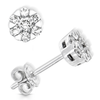Lab-Grown Diamonds vs. Moissanite and Other Alternatives
Introduction
In the quest for sustainable and ethical jewelry, consumers are increasingly faced with a range of choices beyond traditional mined diamonds. Lab-grown diamonds and moissanite are at the forefront of this shift, offering both eco-friendly and affordable alternatives. This post explores these options in depth, comparing their qualities, aesthetics, and impact.
Understanding Lab-Grown Diamonds
Lab-grown diamonds are real diamonds produced in controlled environments, using advanced technological processes that mimic the conditions under which diamonds naturally develop. They share the same physical, chemical, and optical properties as their mined counterparts, making them a genuine diamond option that is both eco-friendly and ethical.
Quality of Lab-Grown Diamonds
Lab-created diamonds are evaluated using the same grading system as natural diamonds, known as the 4Cs: Cut, Color, Clarity, and Carat. They can achieve high grades in all these categories, offering clarity and brilliance that rival natural diamonds.
Sustainability and Ethics
One of the significant advantages of lab-grown diamonds is their reduced environmental impact. Their production requires less energy and water than mining, and they are free from the ethical concerns associated with diamond mining.
Moissanite vs. Synthetic Diamonds
Moissanite is a popular diamond alternative known for its brilliance and durability. While it closely resembles diamonds, moissanite is composed of silicon carbide, making it distinct in both composition and appearance.
Visual Differences and Durability
Moissanite exhibits a fiery, rainbow sparkle that distinguishes it from the more subtle brilliance of diamonds. It ranks just below diamonds on the Mohs scale of hardness, making it very durable and suitable for everyday wear.
Affordability
Moissanite is significantly more affordable than both mined and lab-grown diamonds, making it an attractive option for those seeking a durable and brilliant stone without the diamond price tag.
Comparing Diamond Simulants and Other Alternatives
Cubic Zirconia (CZ)
Cubic Zirconia is another diamond simulant widely used in jewelry. While it can visually mimic a diamond's appearance, CZ is much softer, making it prone to scratches and wear over time. It's the most affordable diamond alternative but lacks the durability and brilliance of lab-grown diamonds and moissanite.
Other Sustainable Gemstones
The jewelry industry has seen a rise in sustainable gemstones like sapphires, rubies, and emeralds that are either lab-created or ethically mined. These gemstones offer a colorful alternative to diamonds while adhering to ethical and environmental standards.
Ethical Jewelry Choices
Choosing between lab-grown diamonds, moissanite, and other alternatives often comes down to personal preference, budget, and ethical considerations. Lab-grown diamonds and moissanite both offer eco-friendly jewelry options for the conscious consumer, with each having its unique benefits.
Jewelry Investment Options
While natural diamonds have traditionally been viewed as an investment, the increasing acceptance and demand for lab-grown diamonds are changing the market dynamics. Lab-grown diamonds and moissanite offer affordable engagement rings and jewelry pieces that don't compromise on quality or ethics.
Conclusion
When deciding between lab-grown diamonds, moissanite, and other diamond alternatives, it's essential to consider the factors most important to you, whether it's the environmental impact, ethical considerations, cost, or the physical properties of the gemstone. With advancements in technology and a shift towards sustainable practices, consumers now have more choices than ever to find jewelry that aligns with their values and desires.
The decision between lab-grown diamonds and alternatives like moissanite doesn't have to be complicated. By understanding the nuances of each option, you can make an informed choice that reflects both your personal style and your commitment to sustainability and ethical sourcing.












